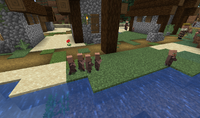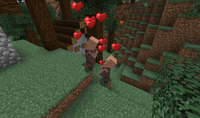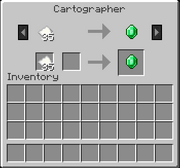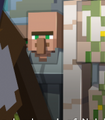Villagers are passive mobs that inhabit villages, with different professions, breed, and interact. Their clothing varies according to their occupation. A player can trade with villagers, using emeralds as currency.
Spawning
Natural generation
in Bedrock Edition, old villagers can only spawn if they existed from a template world prior to 1.11.0, and any old villager spawned after 1.11.0 outside a template world will be converted into villager_v2.
Baby villagers
Villagers will breed autonomously, but need doors and need to be willing in order to spawn baby villagers. After exactly 20 minutes, the baby villager will grow up to an adult. See this section for more information.
Curing
Villagers will spawn if a player uses a splash potion of weakness on a v1 zombie villager in template world and then feeds it a regular golden apple. It will then shake and turn into a villager within 2-5 minutes. During the change, the zombie villager can still burn in the sun.
Drops
Villagers drop nothing upon death.
Behavior
Movement patterns
Upon spawning, villagers will leave their homes and begin to explore the village. Generally, they wander aimlessly inside the village during the day. They may go indoors or outdoors, and they periodically make mumbling sounds. Occasionally, two villagers may stop and turn to look at each other, in a behavior called socializing, in which they will stare at another villager for 4-5 seconds at a time. In the case of players, they will continuously stare at them as long as the player is close enough, unless the villager tries to get into a house at night, farm food, or flee from a zombie.
In Legacy Console Edition, when a player attacks a villager, the villager will not run away, but anger particles will fly out from the villager if it is in a village. In Bedrock Edition, villagers do not stop continuously in front of players. They will also sprint away if the player attacks them.
Villagers, like other mobs, will find paths around obstructions, avoiding walking off cliffs and some blocks that cause harm. However, in crowded situations it is possible for one villager to push another off a cliff or into harm.
At night or during rain, villagers will run inside, closing doors behind them, and staying indoors until morning. In the morning they will head outside and resume normal behavior.
Villagers will run away from zombies, illagers and vexes within 8 blocks.
If a villager finds itself outside the village boundary, or a villager without a village detects a village boundary within 32 blocks, it will move quickly back within the boundary. A villager taken more than 32 blocks away from its village boundary will forget the village within about 6 seconds. Whether in a village or not, a villager is never prone to despawning.
Villagers cannot open trapdoors, fence gates, or iron doors.
There is evidence that villagers are prone to overcrowding certain areas of a village while leaving other areas completely empty. When moving inside, the AI prefers doors within 16 blocks (Euclidean distance). It also tends to prefer doors with fewer villagers nearby, however "nearby" in this case is only 1.5 blocks and, when moving inside, villagers prefer to move 2.5 blocks inside when the inside is to the south or east and therefore will be out of range of this check. During the day, it has been observed that villagers will tend to cluster near a trapped villager or any existing large cluster of villagers, likely due to the "socialize" AI routine overriding their inclination to wander.
Picking up items
Villagers have eight hidden inventory slots, which start empty whenever the villager is spawned. Villagers will not intentionally seek out items to pick up, but they will collect any bread, carrots, potatoes, wheat, seeds, beetroot and beetroot seeds they happen to come within range of. These are the only items they are able to pick up, though the player may use the /replaceitem command to put an arbitrary item into a villager's inventory. If a player and a villager are in the pickup range of an item at the same time, the player will always pick it up first.
Even when gamerule keepInventory is set to false, villagers that are killed with any of the available items above will not drop them once they are killed.
Any items in these slots are lost if a villager becomes a zombie villager; a zombie villager has no inventory slots.
If /gamerule mobGriefing is false, villagers will not pick up items.
A dispenser can be used, if adjacent to a villager, to place armor on it. While not visible in most cases (other than pumpkins and mob heads) the equipment will be fully functional; for example, the Thorns enchantment will hurt zombies that attack a villager with a piece of armor enchanted with the Thorns enchantment equipped.
Sharing food
If a villager has enough food in one inventory stack (6 bread or 24 carrots, potatoes, beetroots, or 18 wheat for farmers only) and sees a villager without enough food in one inventory stack (3 bread or 12 carrots, potatoes or beetroot for non-Farmers; 15 bread, 60 carrots, potatoes, or beetroot, or 45 wheat for Farmers), the villager may decide to share food with that villager.
To share, a villager finds his first inventory stack with at least 4 bread, carrots, potatoes, or beetroot or with at least 6 wheat, and then throws half the stack (rounded down) in the direction of the target villager. When wheat is shared, it is first crafted to bread which may result in 1 or 2 less than half the stack being shared.
Farming
Adult and baby brown-robed villagers, both farmers and other careers, will tend crops within the village boundary. Villagers far enough outside the boundary of any village will also tend nearby crops.
Farmland to be tended is found by seeking for certain blocks up to 15 blocks away from the villager in X and Z and up to 1 away in Y (a 31×31×3 area total).
- If a brown-robed villager does not have enough food in one stack in his inventory (15 bread, 60 carrots, potatoes, or beetroot, or 45 wheat) and finds fully-grown wheat, carrots, potatoes or beetroot, he will move to the crop block and break it.
- If a brown-robed villager has any seeds, carrots, potatoes, or beetroot seeds in his inventory and finds an air block above farmland, he will move to it and plant a crop. They will always plant from the first eligible slot in their inventory.
- If
/gamerule mobGriefingisfalse, villagers will not be able to farm.
Baby villager behavior

A group of villager children playing a game of tag.
Baby villagers will sprint around, entering and leaving houses at will. They will sometimes stop sprinting to stare at an Iron Golem. If the Iron Golem is holding a poppy, the children will cautiously take the flower from its hands. They tend to group and chase one another around the village as if playing tag.
Baby Villagers in Bedrock Edition have a slightly bigger head than in the Console/Java Edition, this also can be seen in different baby mobs in the game as well.
Unlike other breed-able mobs, the parents and child have no personal interactions other than socializing.
Zombies
Zombies will try to find and attack villagers within a 42 block radius (even when the villager is invisible), and will attempt to break down doors. Zombies will only successfully break doors if the difficulty is set to hard, though only a fraction of zombies spawned in hard mode have the capacity to break doors. This also applies to zombie pigmen if they path find through a door. Villagers will run away from zombies, sometimes hiding in houses. The villager's only "natural" defense are the iron golems, which attack nearby hostile mobs.
Zombies will try to kill villagers, or convert them to v1 zombie villagers. The chance that the villager will become a zombie villager on death is 0% on Easy, 50% on Normal, and 100% on Hard. Baby villagers can be infected by zombies as well.
Villagers will also run from zombie pigmen, though the latter will not attack them.
Drowned will chase and attack villagers in the same way zombies will, and villagers will run from drowned in the same way they run from zombies. Drowned can also convert villagers to zombie villagers, even when attacking from a distance with a trident.
Lightning
When lightning strikes within 3–4 blocks of a villager, it will turn into a witch.
Breeding

Two villagers mating.
Villagers will mate depending on the number of valid doors. If "willing" (see below), villagers will mate as long as the population is less than 35% (Bedrock Edition: 100%) of valid doors, rounded down. The type of villager that spawns is independent of the villager's parents.
A valid door is any door within the village radius where the number of "outside" spaces within 5 blocks in a straight line on one side of the door is not the same as the number of "outside" spaces within 5 blocks on the other side of the door. A space is considered to be "outside" if it has nothing but transparent blocks above it all the way to the sky.
A census is periodically taken to determine the current population of the village. All villagers within the horizontal boundary of the village and within 5 vertical blocks (Bedrock Edition: no apparent height limit) of the center will be counted as part of the population to determine if continued villager mating is allowed. However, any villager within the horizontal boundary of the village and within the spherical boundary of the village will attempt to enter mating mode as long as there is at least one villager within the boundary. If two villagers simultaneously enter mating mode while they are close to one another, they will mate with each other and produce a child.
Willingness
Additionally, villagers must be "willing" in order to breed. After mating, they will no longer be willing, and must be made willing again.
Villagers may become willing when the player trades with them. Willingness is granted the first time a new offer is traded, or at a one-in-five chance on subsequent trades. Most of the time, villagers becomes willing after the second or third trade. Green particles will appear if the villager becomes willing by trading. This will not cause them to immediately seek out a mate, however.
Villagers can also become willing by having either 3 bread, 12 carrots, 12 potatoes, or 12 beetroots in one stack in their inventory. Any villager with an excess of food (usually farmers) will throw food to other villagers, allowing them to pick it up and obtain enough food to become willing. The player can also throw bread, carrots, beetroots, or potatoes at the villagers themselves to encourage breeding. Villagers will consume the required food upon becoming willing.
Professions and careers
Each villager has a profession, which can be identified by their clothing. Villagers also have careers specific to their profession. The player can identify a villager's career by reading the title at the top of the trading interface.
Below is a table listing the various villagers, with their careers in relation to their professions, as well as the IDs specifying these. While each profession has a 1 in 6 chance (16.67%) of occurring, the probabilities for individual careers to occur are more diversified. They are listed in the table as well.
When a villager is transformed into a zombie villager, the profession of the zombie villager will remain unchanged. However, the career will be reset and randomly picked again if the zombie villager is cured, allowing for the player to get a villager with a new career and new trade offers. Old trade offers will disappear, even if the same career is chosen again.
Nitwit
| “ |
|
„ | |
| — Jeb about the Nitwit[1] |
The Nitwit villager is a villager that wears a green robe and can not be traded with.
Trading

The pre-1.8 trading interface displaying a trade of 28 paper for 1 emerald.
| “ |
|
„ | |
| — Marsh Davies[2] |
The trading system is a gameplay mechanic that allows players to trade emeralds for items and vice-versa with villagers.Their trades can be good or bad, depending on what the cost is and what items you might get. Trading is only available for adult villagers; the player cannot trade with baby villagers or the nitwit villager.
Right-clicking a villager will allow a player to trade with them, and display their career. Villagers will make offers based on their profession and career, and will only make trades based on whatever offers they are making. Different offers may be viewed by pressing the left and right buttons next to the currently displayed offer. All offers involve emerald as a currency, and some item pertinent to the villager's profession and career. Trading allows the acquisition of rare items that would otherwise be fairly difficult to obtain, such as chain armor. The trading mechanic allows players to get bottle o' enchanting in survival mode. When villagers get a new trade, pink particles and green cross particles appear.
After trading a new offer once, the villager will allow a new tier of offers. After 2-12 times an offer is repeated, the villager will lock the trade offer. That is, the villager will no longer offer this trade. When this happens, the player will have to use another new trade offer in the villager's window once (or several times if it is already used once), and then wait for a short time. If green particles appear, all trades unlock. That is, the villager will start offering all trades. There is a maximum number of tiers each villager can possess, varying by career. Once the villager has unlocked all tiers, it will not open any new ones. However, players will still be able to renew all offers by trading.
Regeneration
When a villager gives off particles from a new trade, they get 10 seconds of regeneration I, which gives them 4![]()
![]() .
.
Commands or external editors can help villagers get new trades.
<If a villager unintentionally picks up certain seeds or crops, it will throw it to another villager to simulate trading between the villagers.>
Data values
Villagers have entity data associated with them that contain various properties of the mob. Their entity ID is villager.
- Entity data
- Tags common to all entities
- Tags common to all mobs
- Additional fields for mobs that can breed
- Profession: The ID of the texture used for this villager. This also influences trading options.
- Riches: Currently unused. Increases by the number of emeralds traded to a villager any time they are traded.
- Career: The ID of this villager's career. This also influences trading options and the villager's name in the GUI (if it does not have a CustomName). If 0, the next time offers are refreshed, the game will assign a new Career and reset CareerLevel to 1.
- CareerLevel: The current level of this villager's trading options. Influences the trading options generated by the villager; if it is greater than their career's maximum level, no new offers are generated. Increments when a trade causes offers to be refreshed. If 0, the next trade to do this will assign a new Career and set CareerLevel to 1. Set to a high enough level and there will be no new trades to release (Career must be set to 1 or above).
- Willing: 1 or 0 (true/false) - true if the villager is willing to mate. Becomes true after certain trades (those which would cause offers to be refreshed), and false after mating.
- Inventory: Each compound tag in this list is an item in the villager's inventory, up to a maximum of 8 slots. Items in two or more slots that can be stacked together will automatically be condensed into one slot. If there are more than 8 slots, the last slot will be removed until the total is 8. If there are 9 slots but two previous slots can be condensed, the last slot will be present after the two other slots are combined.
- An item in the inventory, excluding the Slot tag.
- Tags common to all items
- An item in the inventory, excluding the Slot tag.
- Offers: Is generated when the trading menu is opened for the first time.
- Recipes: List of trade options.
- A trade option.
- rewardExp: 1 or 0 (true/false) - true if this trade will provide XP orb drops. All trades from naturally-generated villagers in Java Edition reward XP orbs.
- maxUses: The maximum number of times this trade can be used before it is disabled. Increases by a random amount from 2 to 12 when offers are refreshed.
- uses: The number of times this trade has been used. The trade becomes disabled when this is greater or equal to maxUses.
- buy: The first 'cost' item, without the Slot tag.
- Tags common to all items
- buyB: May not exist. The second 'cost' item, without the Slot tag.
- Tags common to all items
- sell: The item being sold for each set of cost items, without the Slot tag.
- Tags common to all items
- A trade option.
- Recipes: List of trade options.
Achievements
| Icon | Achievement | In-game description | Actual requirements (if different) | Gamerscore earned | Trophy type (PS4) | |
|---|---|---|---|---|---|---|
| PS4 | Other | |||||
| The Haggler | Acquire or spend 30 Emeralds by trading with villagers or with wandering trader. [sic] | — | 30G | Silver | ||
| Treasure Hunter | Acquire a map from a cartographer villager, then enter the revealed structure | Visit the structure indicated while the purchased map is in your main hand (hotbar). | 40G | Silver | ||
Advancements
| Icon | Advancement | In-game description | Parent | Actual requirements (if different) | Resource location |
|---|---|---|---|---|---|
 | What a Deal! | Successfully trade with a Villager | Adventure | Take an item from a villager or wandering trader's trading output slot, and put it in your inventory. | adventure/trade
|
 | A Throwaway Joke | Throw a Trident at something. Note: Throwing away your only weapon is not a good idea. | Monster Hunter | Hit a mob with a thrown trident. | adventure/throw_trident
|
 | Take Aim | Shoot something with an Arrow | Monster Hunter | Using a bow or a crossbow, shoot an entity with an arrow, tipped arrow, or spectral arrow. | adventure/shoot_arrow
|
 | Very Very Frightening | Strike a Villager with lightning | A Throwaway Joke | Hit a villager with lightning created by a trident with the Channeling enchantment. | adventure/very_very_frightening
|
Trivia
- The villagers were inspired by the shop keepers in Dungeon Master 2.[3]
- Originally, the mobs populating villages were to be pigmen.[4]
- Villagers tend to often cram into houses that are in the southern-eastern area of their village.
- Name tags used on villagers will always name the villager instead of opening the trading interface.
- Villagers can see invisible players.
- After a zombie villager is cured, the villager gets Nausea for 10 seconds (indicated by the purple status effect particles).
- When a villager is in love mode, it walks very slowly. However, when a villager runs indoors as the night falls, it runs extremely fast, even faster than the player's sprinting speed.
- The 1.6 release poster showed a blue-robed villager in the background. Such a villager has never been seen in-game.
- The Priest, Librarian and Nitwit villagers have an unused hood in their textures.
- In the Bedrock Edition, an emerald will appear above a villager while opening the trading GUI.
- The Nitwit has not appeared in the Bedrock Version of Minecraft.
April fools
On April 1, 2014, Mojang announced that villagers have taken over the skin servers and content delivery networks (CDN) as an April Fools joke. This caused players' current skin to turn into villager skins. This also caused users to be unable to change their skins. Different career villager skins were used, including the then-unused nitwit villager (green robe).
Many of the sounds were also changed, supposedly by the villagers. They seem to be similar to a villager talking (with words, rather than their normal sounds). The in-game music has also been altered to include villager like noises, and also features a villager version of the "Game of Thrones" theme on the title screen. The sounds originate from the sound resource pack created by Element Animation, titled The Element Animation Villager Sound Resource Pack (T.E.A.V.S.R.P), which is based on the villagers appearing in their fan videos. The villagers were voiced by Dan Lloyd, Director of Element Animation.
Gallery
Comparison of a villager to a witch
- Steve Villager before 1.5.png
an odd combination of steve and a villager
References
















